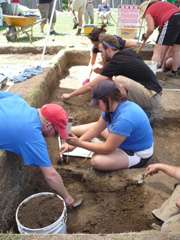Mystery of Ohio's Fort Recovery solved by students

Obscured for more than two centuries lost under several feet of dirt and clay, the original site of historically important Fort Recovery was recently discovered following months of sleuthing by a team from Ball State University.
In the last few weeks, faculty and students involved in an immersive learning experience discovered the location of the east-west palisade of Fort Recovery, which was built in 1793 — during the height of the Indian battles that raged at that time in west central Ohio.
Fifteen anthropology and history students made the find during a five-week field study in Fort Recovery, a historic 1,300-person community located between Fort Wayne, Ind., and Dayton, Ohio.
Mark Groover, an anthropology professor who led the student field study project, said the discovery was similar to a good detective story with lots of clues that had to be put together.
Uncovering the fort's location came early in the spring when Ball State archeologist Chris Keller, a Fort Recovery native, found the trench by using ground-penetrating radar at one of three possible sites.
"I would say this is a pretty significant find for the community as well as our students," Groover said. "The residents knew the fort was somewhere in the vicinity but didn't know the precise location.
"In fact, when we found the trench that was the site for the original wall, we were amazed it was pretty much out in the open — in a small grassy alley not far from Fort Recovery State Museum. But it was up to our students to put all the information together in order to find the place to start the dig."
During the excavation of the site, several artifacts from the late 1700s and early 1800s were found, including shells, scissors, lantern hardware and the middle bracket of a 1766 Charleville musket. The artifacts will be analyzed by Ball State and then returned for display at the museum.
Groover said the site is historically significant because it marked the end of Indian control of that part of what was then the Northwest Territory. A confederacy of Indian warriors defeated a 1,600-man army under Maj. Gen. Arthur St. Clair at this site along the Wabash River in 1791, and the fort was constructed two years later as American forces reoccupied the area.
Possibly the largest-ever assemblage of Indian warriors east of the Mississippi River attacked the fort in 1794 but were driven away by its defenders.
The field study was funded, in part, by a Battlefield Protection Grant from the U.S. Park Service. The students will create a technical report of the findings for the Fort Recovery Museums and the Ohio Historical Society, which owns and manages the property. Another Ball State student group is also conducting a study of the military battle, which should conclude late this year.
Provided by Ball State University














